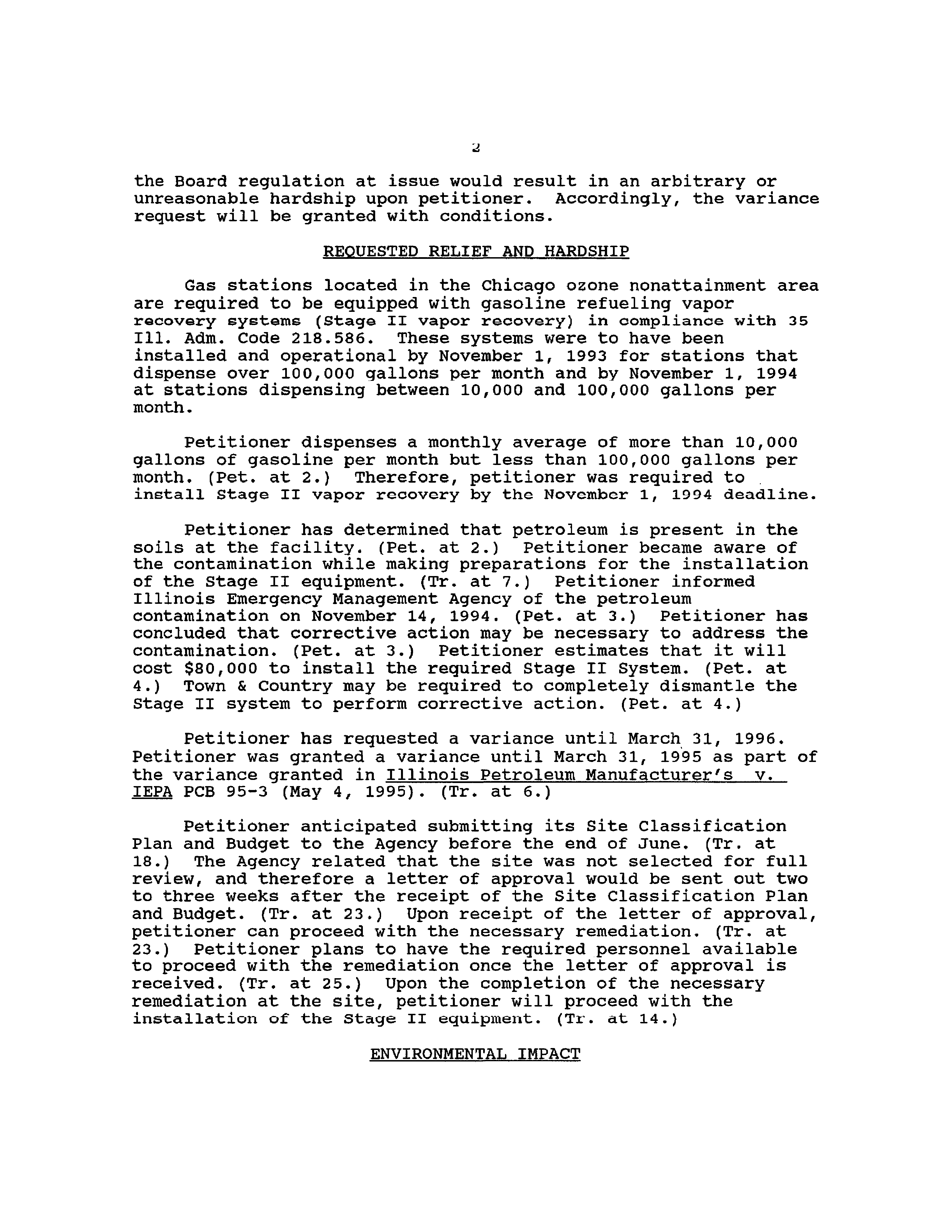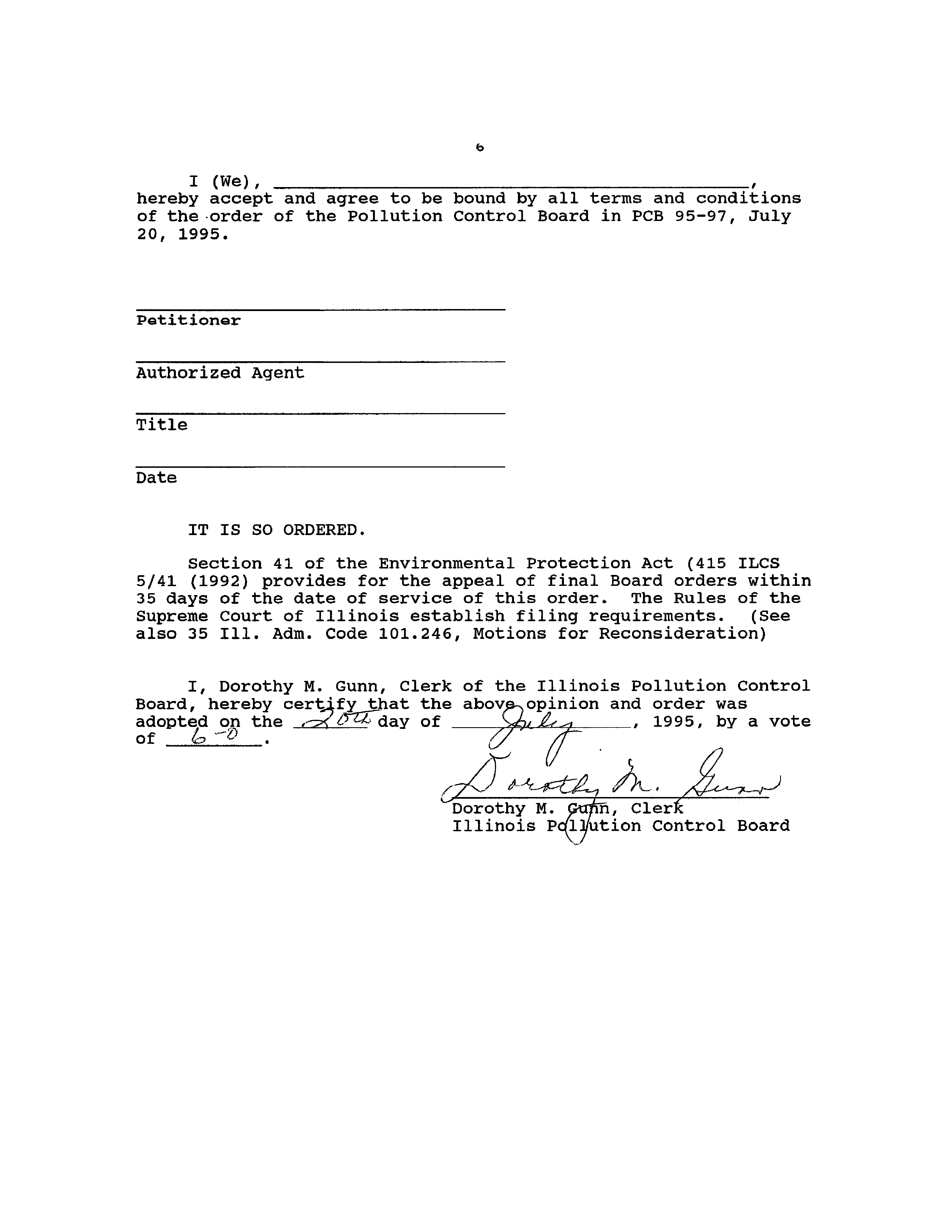ILLINOIS POLLUTION CONTROL BOARD
July 20,
1995
TO1’~N & COUNTRY GAS & FOOD
)
MART,
INC.,
)
)
Petitioner,
v.
)
PCB 95-97
)
(Variance
-
Air)
ILLINOIS ENVIRONMENPAL
PROTECTION AGENCY,
)
Respondent.
STEVEN KAISER, THE JEFF DIVER GROUP, APPEARED ON BEHALF OF
PETITIONER;
CHRISTINA L. ARCHER APPEARED ON BEHALF OF RESPONDENT.
OPINION AND ORDER OF THE BOARD
(by E.
Dunham)
On March 14,
1995, Town & Country Gas & Food Mart,
Inc.
(Town & Country)
filed a petition
(Pet.) for variance from
35
Ill. Adm. Code 218.586(d) (3), for its facility located at 10007
S. Michigan Ave., Chicago, Cook County,
Illinois.
Section
218.586(d)
is the Board’s regulation requiring the installation
of Stage
II gasoline vapor recovery equipment.
The Board’s responsibility in this matter arises from the
Environmental Protection Act
(Act)
(415 ILCS
5/1
et seq.
(1992).)
The Board is charged therein with the responsibility of granting
variance from Board regulations whenever it is found that
compliance with the regulations would impose an arbitrary or
unreasonable hardship upon the petitioner.
(415 ILCS 5/35 (a).)
The Illinois Environmental Protection Agency
(Agency)
is required
to appear in hearings on variance petitions.
(415
ILCS 5/4(f).)
The Agency is also chargea, among other matters, with the
responsibility of investigating each variance petition and making
a recommendation to the Board as to the disposition of the
petition.
(415 ILCS 5/37(a).)
The Agency filed its variance recommendation
(Rec.) on June
13, 1995.
The Agency contends that an unreasonable hardship
would be imposed on petitioner in the absence of the requested
relief.
(Rec. at
8.)
Accordingly, the Agency recommends granting
the variance, subject to conditions.
Hearing was held on June 22, 1995 before hearing officer
June Edvenson in Chicago, Illinois.
No members of the public
attended the hearing.
No briefs were filed.
As presented below, the
Board finds that Town
& Country has
met its burden of
demonstrating that immediate compliance with
2
the Board regulation at issue would result in an arbitrary or
unreasonable hardship upon petitioner.
Accordingly, the variance
request will be granted with conditions.
REQUESTED RELIEF
AND
HARDSHIP
Gas stations located in the Chicago ozone nonattainment area
are required to be equipped with gasoline refueling vapor
recovery systems
(Stage II vapor recovery)
in compliance with 35
Ill.
Adm. Code 218.586.
These systems were to have been
installed and operational by November 1,
1993 for stations that
dispense over 100,000 gallons per month and by November 1,
1994
at stations dispensing between
10,000
and 100,000 gallons per
month.
Petitioner dispenses a monthly average of more than 10,000
gallons of gasoline per month but less than 100,000 gallons per
month.
(Pet. at 2.)
Therefore, petitioner was required to
install Stage II vapor recovery by the November 1,
1994 deadline.
Petitioner has determined that petroleum is present in the
soils at the facility.
(Pet.
at 2.)
Petitioner became aware of
the contamination while making preparations for the installation
of the Stage II equipment.
(Tr.
at
7.)
Petitioner informed
Illinois Emergency Management Agency of the petroleum
contamination on November 14,
1994.
(Pet.
at
3.)
Petitioner has
concluded that corrective action may be necessary to address the
contamination.
(Pet.
at 3.)
Petitioner estimates that it will
cost $80,000 to install the required Stage II System.
(Pet.
at
4.)
Town & Country may be required to completely dismantle the
Stage II system to perform corrective action.
(Pet.
at 4.)
Petitioner has requested a variance until March 31,
1996.
Petitioner was granted a variance until March 31, 1995 as part of
the variance granted in Illinois Petroleum Manufacturer’s
v.
IEPA PCB 95—3
(May
4,
1995).
(Tr. at
6.)
Petitioner anticipated submitting its Site Classification
Plan and Budget to the Agency before the end of June.
(Tr.
at
18.)
The Agency related that the site was not selected for full
review,
and therefore a letter of approval would be sent out two
to three weeks after the receipt of the Site Classification Plan
and Budget.
(Tr.
at
23.)
Upon receipt of the letter of approval,
petitioner can proceed with the necessary remediation.
(Tr. at
23.)
Petitioner plans to have the required personnel available
to proceed with the remediation once the letter of approval is
received.
(Pr.
at 25.)
Upon the completion of the necessary
remediation at the site,
petitioner will proceed with the
installation of the Stage II equipment.
(Tr.
at 14.)
ENVIRONMENTAL IMPACT
j
During the dispensing of gasoline, volatile organic
compounds
(VOC,
also known as volatile organic material or VOM)
are emitted into the atmosphere.
American Petroleum Institute
(API)
estimates that uncontrolled emissions due to vehicle
refueling equals approximately 11.7 pounds of VOC per 1,000
gallons or tuel dispensed.
(Pet.
at 4.)
The Agency has estimated
in its 1990 Chicago Ozone SIP Inventory Summary that on a weekday
during the ozone season total VOM emissions are 1453.69 tons.
(Pet.
at 4.)
Petitioner estimates that it dispenses an average of 45,000
gallons a gasoline per month.
(Pet.
at
4.)
The Agency estimates
the uncontrolled VOM emissions from this source at
.0086 tons per
day.
(Rec. at 4.)
The Agency estimates this figure at
.00059
of
the Chicago area daily total.
(Rec.
at
5.)
The Agency is very concerned with the reduction of emissions
of VOM in the
Chicago
area and is engaged in a massive effort to
develop methods to reduce emissions.
(flea.
at
4.)
The requested
variance would allow petitioner to emit uncontrolled VOM
emissions throughout the 1995 ozone season (April
-
October).
(Rec.
at
5.)
The Agency notes that the requested variance would
not extend into the 1996 ozone season.
(Rec. at 5.)
The Agency contends that the emissions from petitioner’s
station are not that significant compared to the total Chicago
area VOM.
(Rec.
at
5.)
However, the Agency maintains that the
ozone problem in Chicago is largely attributable to numerous
small sources that when aggregated,
create significant emissions.
(Rec.
at
5.)
The Agency believes that the hardship incurred by the
petitioner in installing Stage II equipment only to dismantle and
reinstall the equipment if remediation proves necessary outweighs
the environmental impact from allowing the facility to emit
uncontrolled VOM5 through the 1995 ozone season.
(Rec.
at
5.)
The Agency also notes that petitioner
is seeking relief to
mitigate potential environmental damage from the soil
contamination.
(Rec.
at
5.)
The Agency maintains that petitioner
should be able to complete any necessary remediation prior to the
1996 ozone season.
(Rec.
at 5.)
CONSISTENCY WITH FEDERAL LAW
The Agency contends that granting the requested variance
would be consistent with federal
law.
(Rec.
at
6.)
The Agency
asserts that the Stage II requirements are an important component
of the State’s plan to achieve reductions of 15.
(Rec.
at 6.)
The Agency contends that the granting of the variance will not
impede the State’s efforts at achieving the 15
reduction in VOM
emissions because petitioner dispenses
a lower volume of
gasoline.
(Rec.
at 6.)
‘1
CONCLUSION
In determining whether any variance is to be granted, the
Act requires the Board to determine whether a petitioner has
presented adequate proof that immediate compliance with the Board
regulations at issue would impose an arbitrary and unreasonable
hardship upon the petitioner.
(415 ILCS 5/35(a)
(1992).)
Furthermore, the burden is on the petitioner to show that its
claimed hardship outweighs the public interest in attaining
compliance with regulations designed to protect the public.
(Willowbrook Motel v. IPCB
(1985),
135 Ill.App.3d 343, 481 N.E.2d
1032.)
Only with such a showing can the claimed hardship rise to
the level of arbitrary or unreasonable hardship.
Based upon the record before it and upon review of the
hardship petitioner would encounter,
and the environmental impact
that would result from grant of variance, the Board finds that
Town & Country has presented adequate proof that immediate
compliance with the regulations at issue would result in an
arbitrary and unreasonable hardship on petitioner.
The Board notes that it is a well established practice that
the term of a variance begins on the date the Board renders its
decision unless unusual or extraordinary circumstances are shown.
(See,
e.g.
DM1,
Inc.
v. IEPA (December 19, 1991), PCB 90-277,
128
PCB 245-249.)
Petitioner first became aware of the contamination
and the possible need of remediation during the preparation for
installation of the Stage II equipment.
Upon discovering the
contamination at the site, petitioner took action to determine
the extent of contamination and the need for remediation.
Petitioner is seeking this variance until the completion of the
remediation process.
In view of the facts of this case,
the
Board finds that the instant circumstances warrant a retroactive
start of the variance.
The requested variance accordingly will
be granted,
subject to conditions consistent with this opinion.
This opinion constitutes the Board’s findings of fact and
conclusions of law in this matter.
ORDER
A.
Town & Country is hereby granted a variance from 35 Ill.
Adm. Code 218.586(d) (3)
as it pertains to the requirement
for Stage II gasoline vapor recovery equipment at its
facility located at 10007
S. Michigan Ave.,
Chicago, Cook
County, Illinois commencing on April
1,
1995 subject to the
following conditions:
1.
If the site classification concludes that no further
remediation is necessary,
petitioner will complete
installation of Stage II equipment within 45 days of
5
the Agency’s concurrence with this conclusion, but in
no case later than March 31,
1996.
2.
If the site is classified as low priority, petitioner
will complete installation of Stage II equipment within
45 days of the Agency’s concurrence with the
classification, but in no case later than March
31,
1996.
3.
If remediation is required but the method of
remediation selected will not interfere with Stage II
equipment,
petitioner shall install Stage II equipment
within 45 days of approval of the method of
remediation, but in no case later than March 31,
1996.
4.
If the site is classified, and requires further
remediation, petitioner will install Stage II equipment
within 45 days of completion of remediation, but in no
case later than March 31,
1996.
5.
Petitioner shall notify Terry Sweitzer of the Agency as
to the classification of the site within 14 days of
receipt of site classification approval.
Such notice
shall be sent to:
Terry Sweitzer
Illinois Environmental Protection Agency
Bureau of Air
P.O. Box 19276
Springfield, Illinois 62794—9276
6.
Petitioner shall notify the Agency of the installation
of any Stage II equipment within 14 days after its
installation.
Notification shall include the address
of the facility and shall be sent to Terry Sweitzer at
the address above.
Within 45 days of the date of this order, petitioner shall
execute and forward to Christina Archer, Division of Legal
Counsel, Illinois Environmental Protection Agency,
2200 Churchill
Road,
Post Office Box 19276,
Springfield, Illinois 62794—9276,
a
Certification of Acceptance and Agreement to be bound to all
terms and conditions of this variance.
The 45-day period shall
be held in abeyance during any period that this matter is being
appealed.
Failure to execute and forward the Certificate within
45 days renders this variance void and of no force and effect as
a shield against enforcement of rules from which variance was
granted.
The form of said Certification shall be as follows:
CERTIFICATION
b
I
(We),
hereby accept and agree to be bound by all terms and conditions
of the-order of the Pollution Control Board in PCB 95-97,
July
20,
1995.
PQtitioner
Authorized Agent
Title
Date
IT IS SO ORDERED.
Section
41
of the Environmental Protection Act
(415 ILCS
5/41
(1992) provides for the appeal of final Board orders within
35 days of the date of service of this order.
The Rules of the
Supreme Court of Illinois establish filing requirements.
(See
also 35 Ill.
Adm. Code 101.246, Motions for Reconsideration)
I, Dorothy M.
Gunn,
Clerk of the Illinois Pollution Control
Board, hereby cert4fy that the abov
opinion and order was
adopted on the ,-~~~dayof
~
,
1995, by a vote
of
_____.
~Dorothy M.
2u~’i?i, Cler1~
Illinois Pc(lyution Control Board






